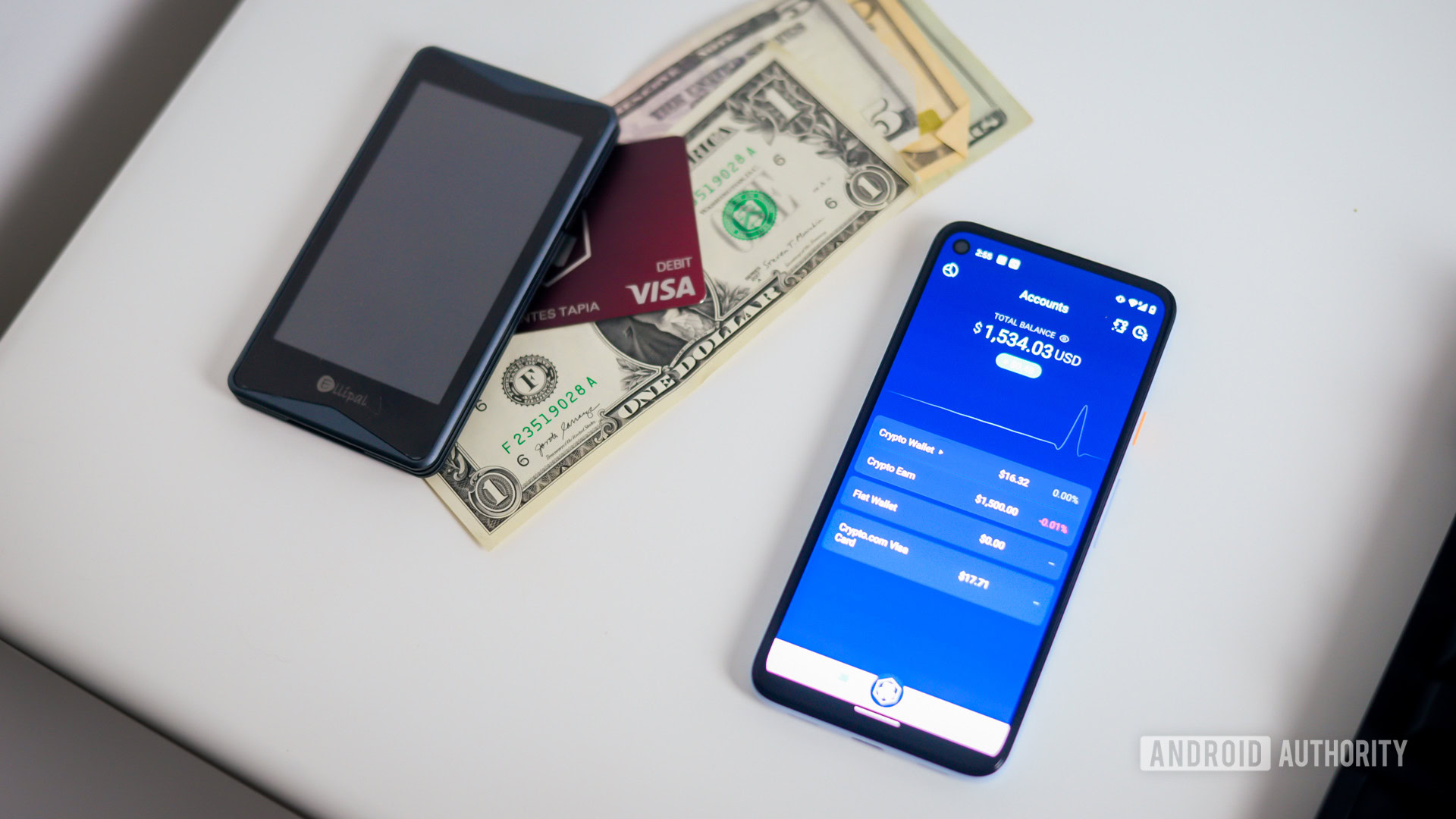
Edgar Cervantes / Android Authority
Decentralized finance, or DeFi, is rapidly emerging as one of the most promising applications of cryptocurrency technology. And while it may sound complicated, DeFi is just an umbrella term used to describe financial products and services that are completely independent of any authorities.
Imagine a world where common services such as loans, cross-border payments, insurance, and retirement savings don’t require a bank account or approval from an authority. That is DeFi’s vision essentially, to establish an open standard. This new standard doesn’t leave room for predatory intermediaries or third parties either — and promises to herald a new era of financial efficiency, inclusion, and transparency.
Indeed, those are a lot of bold claims. So in this article, let’s examine this emerging technology, understand how it works, and how it will likely influence your financial life in the future.
What is Decentralized Finance (DeFi)?
Edgar Cervantes / Android Authority
Before we dive into the nitty-gritty of how DeFi works, it’s important first to understand the way things currently work in the world of traditional finance, or TradFi as it is sometimes called in cryptocurrency circles.
Say you want to trade one asset for another, like stocks for cash — you would need an exchange or trading platform to facilitate this trade. Now assume you’re in the market for a new car or house and require a loan. What are your only options? A bank or local credit union, at best. Whether you’re trying to save money for your retirement or transferring money abroad, you typically have to trust one or multiple institutions to achieve that goal.
On the surface, trusting such institutions doesn’t seem too problematic as they’ve been around for decades, if not centuries. Dig only a little deeper, though, and the finance sector’s controversial past, including events such as the 2008 mortgage crisis, can leave you wondering if your trust is perhaps misplaced.
However, even if you aren’t distrustful of modern banking practices, you are undoubtedly affected by them in one way or another. High commissions, arbitrary restrictions, and red tape are commonplace today, despite technology to eliminate these long-standing complaints.
The DeFi sector hopes to eliminate the banking industry’s high commissions, arbitrary restrictions, and red tape.
Enter the DeFi sector, which aims to finally fix these issues by eliminating central authorities and intermediaries. What’s replacing them, you ask? An automated computer network that distributes control instead of concentrating it at the top. DeFi applications are typically built on top of decentralized blockchain networks such as Ethereum.
DeFi has the potential to take blockchain technology from serving as a simple record of payment to a full-fledged economy. DeFi proposes recreating these financial services — including loans, cross-border payments, and interest-generating savings accounts — but minus the middlemen and other annoyances.
The crux of the DeFi movement is perhaps best explained by the co-founder of Ethereum, who once said,
Whereas most technologies tend to automate workers on the periphery doing menial tasks, blockchains automate away the center. Instead of putting the taxi driver out of a job, blockchain puts Uber out of a job and lets the taxi drivers work with the customer directly.
Why is DeFi special?

Edgar Cervantes / Android Authority
As is probably evident by now, DeFi’s goals are in stark contrast to PayPal, Robinhood, and hundreds of other fintech companies. The latter often go to great lengths to keep users invested and engaged within their walled ecosystems.
Beyond that simple distinction, here is a quick summary of DeFi’s advantages and why its proponents view it as a superior alternative to traditional finance.
- Since blockchain technology is decentralized and does not rely on central banks or fiat currencies, DeFi is global and borderless.
- DeFi eliminates intermediaries. This, in turn, saves users from having to deal with lengthy approval processes, paperwork, fees, and even discrimination.
- Besides efficiency, DeFi platforms could potentially offer improved security and privacy, with lower risks of data leaks. In the case of popular projects, at least, bugs and glaring security issues are often peer-reviewed and fixed before updates are released to the public.
- Cryptocurrencies have a low barrier to entry. Anyone with a smartphone and internet connection can create a cryptocurrency wallet and enjoy equal access to DeFi services.
- Banks often struggle to offer financial services in less developed areas. According to the World Bank, around 1.7 billion people don’t have access to financial services. DeFi doesn’t require identification or other labor-intensive processes and could bank the unbanked.
How do DeFi apps work?

DeFi apps and services rely on a specific blockchain-derived technology called smart contracts. These are essentially digital contracts that execute automatically when some condition is met. Anyone can create and publish their own smart contracts on a blockchain platform like Ethereum. And once signed by the concerned parties, the contract cannot be modified or tampered with.
All of these properties make smart contracts perfect for automatically enforcing the terms of even the most sophisticated agreements in finance, such as loan repayments and insurance payouts. Most notably, all of this is achieved without a single human third-party or higher authority.
Developers create smart contracts just like any other piece of software you interact with. A bundle of such digital contracts is often referred to as a decentralized application, or dapp.
Decentralized applications execute their code on blockchain networks, making them transparent and auditable.
However, developers don’t publish their code to something like the Play Store on your phone. Instead, dapps are uploaded to the global Ethereum blockchain by way of a simple transaction. Once published, users can interact with the dapp or underlying smart contract through new transactions of their own.
Take the following smart contract-affiliated transaction on the Ethereum blockchain, for example.
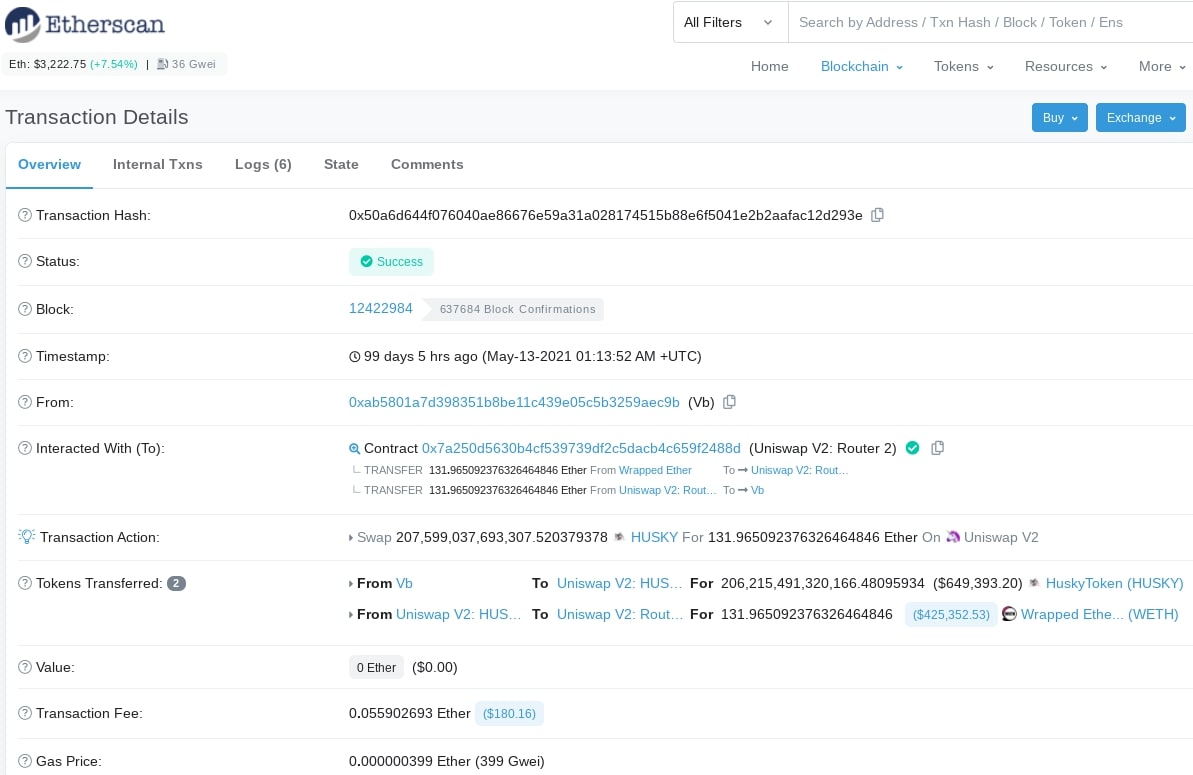
The Interacted With and Transaction Action fields specifically tell us that the wallet owner interacted with a smart contract named Uniswap. More importantly, this particular transaction facilitated a simple swap between a relatively obscure token and Ethereum. As you can see, everything was not only transparent, but also instantaneous — in line with the promises DeFi is built upon.
However, none of this information is particularly worth knowing except as an academic exercise. The frontend for most dapps is far simpler and user-friendly. In fact, you’ll likely use a cryptocurrency wallet on your smartphone or computer to interact with these apps.
Read more: 10 best crypto wallets for Android
Most Ethereum wallets can talk to dapps these days, and we even explored some of the best options in our roundup of software wallets. As for which dapps in the DeFi space are worth using, we’ll explore some of the most popular projects in a later section.
Will DeFi disrupt the existing financial landscape?
Decentralized finance has plenty of potential to reach the world’s unbanked population — that much is clear. However, if you already have an existing relationship with financial institutions, what does DeFi offer and do better? Here are a couple of examples:
Cashless payments with lower fees
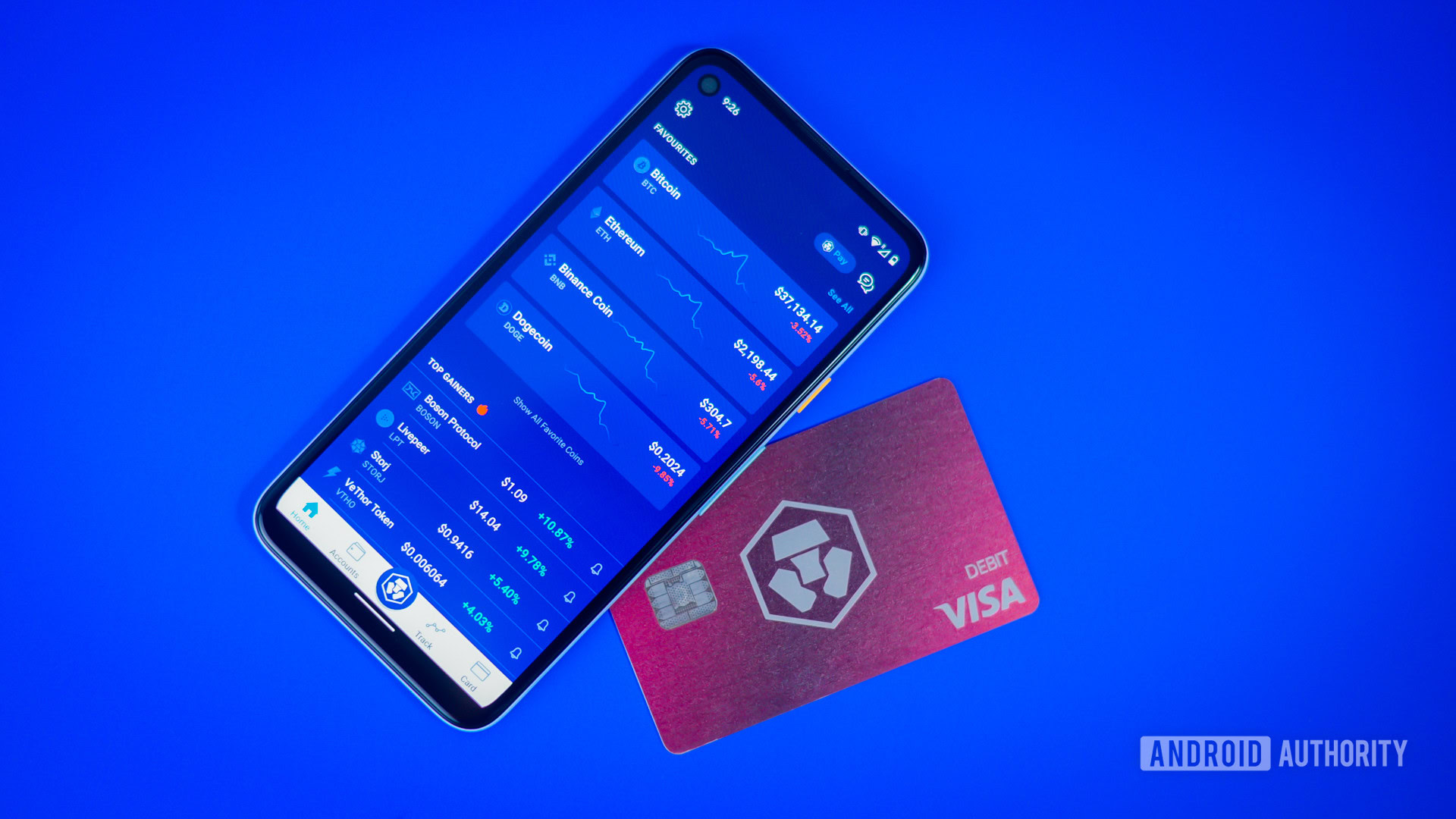
Edgar Cervantes / Android Authority
Did you know that credit card companies like Visa and Mastercard charge businesses anywhere between 1.3% to 3.5% in processing fees? Even though you don’t pay these companies anything out of your own pocket, the opposite party most likely is. In most cases, businesses have to choose between paying this fee or losing business from customers in the long term.
What’s worse is that businesses often factor this cost into the price of goods and services, so you likely end up paying that fee without even realizing it. While merchants could, in theory, offer cash discounts, there are often several hoops to jump through — including listing both cash and card prices on shelves or menus, among other region-specific laws.
A report by the U.S. Federal Reserve revealed that interchange fees topped a staggering $24 billion in 2019. The COVID-19 pandemic likely only accelerated this number as more and more consumers embraced cashless modes of payment.
So how does all of this tie into DeFi? Simply put, credit cards are among the dozens of financial applications that DeFi could replace or overhaul in the coming years. Companies like Mastercard and Visa realize this, and are also leaning towards adopting the technology.
If DeFi is successful, increased competition should lower fees for both merchants and consumers.
For proof of this changing landscape, take a look at Amazon Singapore. In August 2021, it announced an unprecedented 0.5% surcharge on Visa card transactions. It’s probably no coincidence that Amazon and Walmart also began hiring cryptocurrency and blockchain experts around the same time.
Instantaneous loans and lending opportunities
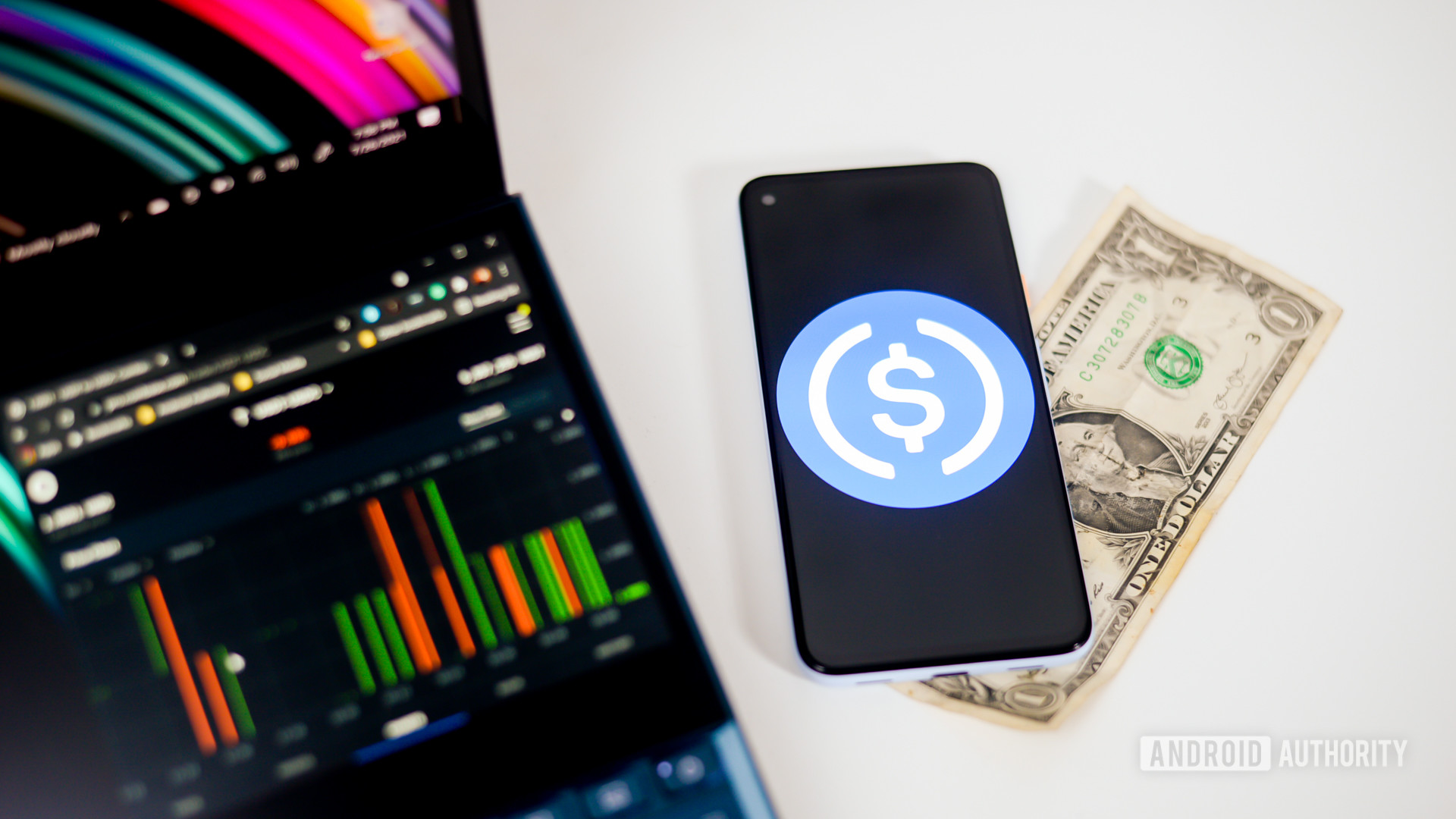
Edgar Cervantes / Android Authority
For decades now, individuals have relied on banks and financial institutions to deliver loans. Somewhat unfortunately, however, lenders are neither universally fair nor inclusive. Furthermore, the process of getting a loan approved involves navigating a complex web of documentation and human oversight. Obtaining a loan isn’t as simple as proving your ability to pay it back these days.
Over the past couple of years, the DeFi sector has offered a glimpse at how blockchain and cryptocurrency technologies could democratize lending and borrowing. The biggest names in this segment today are Maker, Aave, and Compound.
In a nutshell, these are platforms that allow you to earn interest on deposited cryptocurrency. For instance, Aave currently offers an annual interest rate of around 3% if you deposit stablecoins such as DAI, Tether, or USD Coin. Other individuals can then borrow from this pool of deposits at a slightly higher interest rate.
Read more: What is Tether (USDT)? Everything you need to know about stablecoins
The difference between traditional loans and DeFi ones is that the process is fully automated, from start to finish. As a borrower, you’re expected to offer some collateral equal to the value you’re borrowing. If you default on your future monthly payments, another smart contract can liquidate your collateral to close the loan.
While collateralized loans are nothing new, they are fraught with delays and high fees in the traditional finance space. A well-thought-out decentralized lending platform offers a passive revenue stream to lenders that’s otherwise only available to banks and large financial institutions. Borrowers, meanwhile, don’t even need a bank account to obtain a loan.
A decentralized lending platform offers lenders a stream of passive revenue that’s otherwise only available to banks and large financial institutions.
Today’s DeFi loans typically ask for cryptocurrency as collateral, and issue stablecoins or other cryptocurrencies in return. In a few years, though, DeFi supporters believe the technology could be applied to other forms of collateral, including mortgages and even unsecured loans.
Real-world DeFi applications you can try today
Given how closely the DeFi and cryptocurrency industries are linked, it’s no surprise that the vast majority of applications revolve around digital currencies as well. Estimates indicate that DeFi has already amassed $100 billion in user deposited value.
You need to be at least ankle-deep in the cryptocurrency ecosystem to realize the technology’s benefits today. Luckily, all you need to create a cryptocurrency wallet is a computer and internet connection. Here are some of the most prominent DeFi applications available today.
Decentralized exchanges

Edgar Cervantes / Android Authority
Apps: Uniswap, SushiSwap, Matcha
If you have ever exchanged one cryptocurrency token for another, you’ve probably used a centralized cryptocurrency exchange like Coinbase or Binance. A decentralized exchange, or DEX, offers similar functionality without a private company acting as an intermediary.
Read more: A definitive guide to buying and selling cryptocurrency
Uniswap, for example, allows you to trade between various cryptocurrencies instantly. Simply select the tokens you’d like to swap and enter the amount. As soon as the funds leave your wallet, a smart contract on the Ethereum blockchain will process the trade and deposit the other token back into your wallet.
The entire process is transparent so that you can keep track of its status via any Ethereum blockchain explorer. In contrast to centralized exchanges, which require you to deposit your cryptocurrency to trade, Uniswap is non-custodial. The fees are considerably lower unless the Ethereum network is congested, but more on that in a later section.
Lending
Apps: Aave, Compound, Oasis
If you’ve got a cryptocurrency balance sitting in a digital wallet, you can earn interest on it by lending a portion of it out. This makes your holdings productive, while taking on minimal risk in the process.
Getting started with lending is pretty simple. The only limitation, for now, is that you need to own an Ethereum-based token to participate. Most popular ERC-20 tokens are supported, with a popular choice being the stablecoin DAI.
Prediction markets
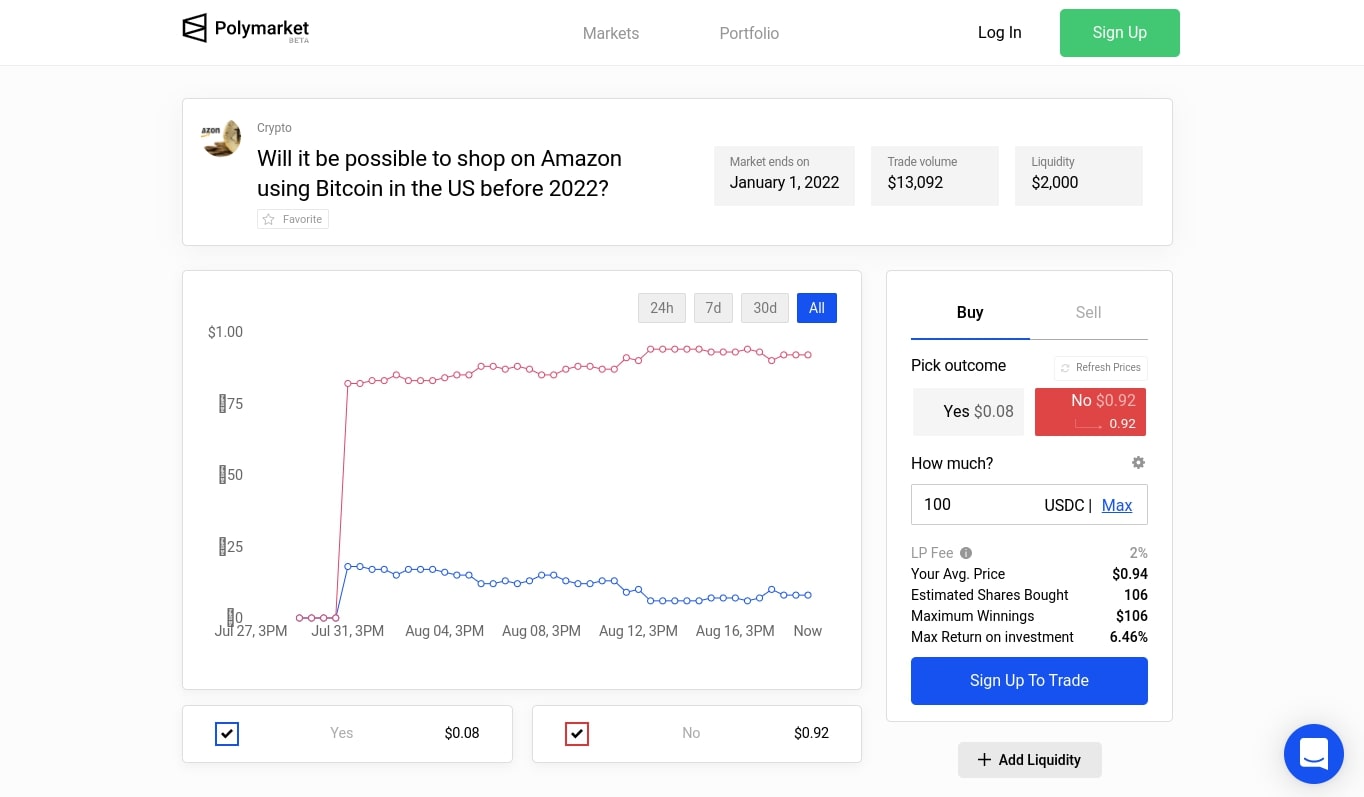
If you’ve ever wanted to bet on the outcome of an event, decentralized prediction markets are for you. While not a financial service per se, these platforms showcase the strengths of DeFi and blockchain technology perfectly.
Prediction markets allow individuals to speculate on future events by buying “shares” of either outcome. Take a look at the screenshot above, for example.
The event here is Amazon accepting Bitcoin as a payment method by 2022. Obviously, the probability of this happening is relatively low, and people have bought “shares” of the No outcome to reflect this. According to Polymarket’s documentation,
If the price for a “Yes” share is $0.75, then the market believes the probability that the event will occur is 75%.
However, if Amazon did start accepting Bitcoin-based payments, the market would stand resolved, and anyone that bought shares of the once-unlikely Yes outcome would then be able to sell at much higher prices.
Read more: Bitcoin explained: The controversial digital currency worth billions
As is probably evident by now, DeFi has limitless potential, even in sectors that existing financial giants don’t typically cover. We recommend checking out this list maintained by the Ethereum Foundation for a more expansive list of use-cases.
What are the downsides to DeFi?

Edgar Cervantes / Android Authority
So far, we’ve only really discussed the merits of DeFi. Admittedly, however, various unknown factors and potential pitfalls could render the technology infeasible. While many believe these are just growing pains that will eventually go away, they’re still worth acknowledging today.
For starters, the DeFi ecosystem’s lack of intermediaries could create a vacuum where malicious actors or even outright fraudulent behavior can run rampant. Take the previous example of credit cards, for example. For all the fees Visa and Mastercard collect from merchants, they do offer tangible benefits to both businesses and consumers in the form of grievance redressal and dispute resolution.
In its current form, most of DeFi is limited to those with uninterrupted internet access and an above-average understanding of technology.
Then there’s also the problem of user education and approachability. In its current form, most of DeFi is limited to those with uninterrupted internet access and an above-average understanding of technology. Meeting the needs of the unbanked goes beyond just eliminating intermediaries or fees — the technology needs to improve in terms of inclusion.
Finally, there’s the problem of regulatory acceptance. While DeFi can clearly do a lot of good for the average individual, the same can be said for crafty criminal enterprises. Governments worldwide are naturally wary of misuse and will want to regulate the ecosystem at some point.
Each country will likely take a while to develop laws that strike a balance between embracing DeFi and preventing its use as an anonymous tax haven or laundering scheme. Still, given how traceable blockchains are, regulatory uncertainty will likely not be a long-standing problem. This also doesn’t faze many DeFi supporters that clamor for healthy regulation anyway.
The future of DeFi: What comes next?

Edgar Cervantes / Android Authority
Believe it or not, most DeFi applications have not been around for very long. Even though Bitcoin is well over ten years old, the inflection point for the decentralized finance sector didn’t occur until 2020. Colloquially called DeFi Summer, it saw apps such as Uniswap and Compound rally out of seemingly nowhere.
DeFi growth hasn’t exactly stalled since then, but it certainly is not as explosive anymore. While it’s unreasonable to expect a continuous upward trajectory, there’s another reason for DeFi’s slowing trend: blockchain scalability, or lack thereof.
For years now, the Ethereum network has suffered from long periods of congestion due to high transaction volumes. Unfortunately, the network can only handle a dozen transactions per second in its current state. Since using a DeFi platform almost always involves initiating an Ethereum transaction, high usage frequently causes transaction fees to balloon beyond reasonable levels.
High fees currently render most DeFi applications unusable. To that end, scalability is the most important goal for developers.
Thankfully, Ethereum’s development team and community are jointly working on a solution to this long-standing problem. Dubbed Ethereum 2.0, the overhaul aims to do away with the random transaction verification process in favor of a new system called Proof of Stake (PoS). Ultimately, it will allow the blockchain network to process many more transactions per second.
Until transactions are cheaper, Ethereum’s DeFi growth may continue to witness some slowdown. Still, not a single metric suggests that the network is small right now, especially considering it is valued at around $500 billion. Besides Ethereum, other smart contract platforms could also help alleviate the influx of new users and high transaction volumes.
This news is republished from another source. You can check the original article here

Be the first to comment